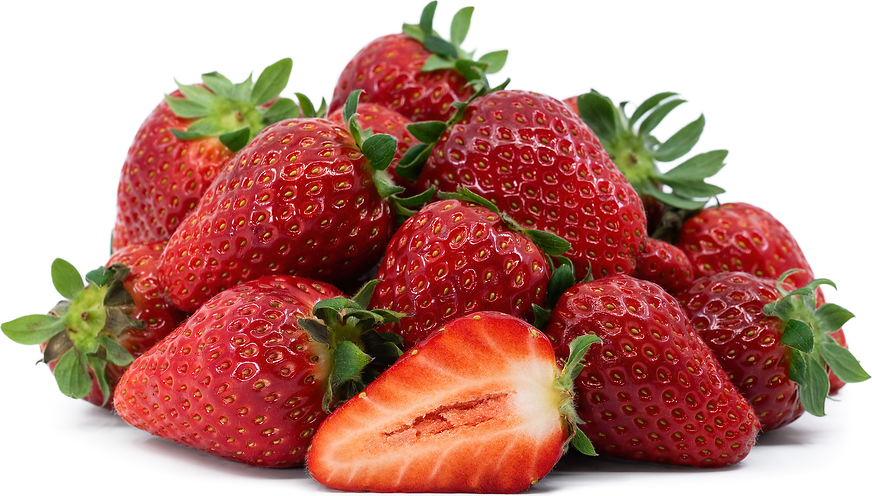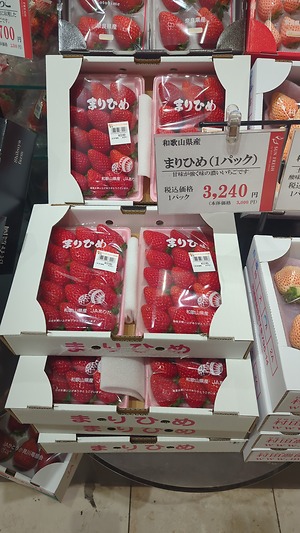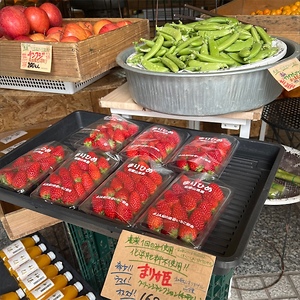


Marihime Strawberries
Estimated Inventory, ea : 0
Description/Taste
Marihime strawberries are a medium to large varietal, averaging 18 to 19 grams in weight, and have a slightly elongated, uniform, conical shape with curved shoulders tapering to a slender pointed tip. The strawberries are topped with large, dark green caps bearing broad, flat, and lanceolate-shaped leaves that cover the fruit's shoulders. The skin is glossy, smooth, firm, and bright red, covered in tiny yellow to brown edible seeds. Underneath the surface, the flesh ranges in color from pale red, pink, to a blend of white, pink, and red hues, and the central core may appear solid or partially hollow. The flesh is also plump with an aqueous, crisp, tender, and succulent consistency. Marihime strawberries have high sugar levels mixed with moderate to low acidity, depending on specific growing conditions. The strawberries are known for their aromatic nature, and it is said that their sweet and fruity flavor spreads throughout the mouth, leaving a pleasant, lingering sweetness.
Seasons/Availability
Marihime strawberries are available in the winter through spring.
Current Facts
Marihime strawberries, botanically classified as Fragaria ananassa, are a specialty variety belonging to the Rosaceae family. The variety was developed in the early 21st century in Japan and is exclusively grown in the Wakayama Prefecture. Marihime strawberries were specifically designed as an early-ripening variety that arrives in commercial markets before the winter holiday season. The variety was also selected for its uniform shape, sweet taste, and productive nature. In the Wakayama Prefecture, Sachinoka strawberries were once the main commercial variety, but due to their late-season nature, scientists created Marihime strawberries to complement Sachinoka strawberries to extend the Wakayama strawberry season. Marihime strawberries are produced on a small scale and are sold domestically throughout Japan and internationally, exported to other countries in Asia. The variety is primarily consumed fresh, though sometimes incorporated into cooked preparations, and is a favorite ingredient in culinary dishes and beverages.
Nutritional Value
Marihime strawberries are a source of vitamin C to strengthen the immune system, vitamin E to reduce inflammation, and fiber to regulate the digestive tract. The strawberries also provide potassium to balance fluid levels within the body, manganese to support metabolism, folate to produce RNA and DNA, and other nutrients, including iron, vitamin K, phosphorus, and copper.
Applications
Marihime strawberries have a sweet, fruity taste suited for fresh and cooked preparations. The variety is primarily consumed out of hand and is favored for its juicy, semi-firm, but tender nature. Marihime strawberries are popularly dipped into condensed milk as a snack or combined with red bean paste and stuffed into mochi as a dessert. In Japan, the strawberries are served in desserts throughout the Wakayama Prefecture and used as a decorative topping on cakes, tarts, parfaits, and crepes. They can also be sliced and added on toast, chopped fresh into salads, fruit medleys, and grain bowls, or layered into a sweet fruit sandwich consisting of salty bread, whipped cream or mascarpone, and strawberries. In addition to fresh preparations, Marihime strawberries can be simmered into jellies, jams, and preserves or baked into tarts, pies, and cakes. Beyond culinary dishes, the variety can be blended into smoothies and milkshakes, muddled into cocktails, or pressed into fruit juices. Marihime strawberries pair well with fruits such as raspberries, blueberries, grapes, apples, citrus, and pineapple, chocolate, vanilla, maple syrup, nuts including pistachios, almonds, and pecans, and herbs such as mint, basil, and rosemary. Whole, unwashed Marihime strawberries should be immediately consumed for the best quality and flavor. Strawberries begin losing their sugar content the moment they are harvested and will keep for 2 to 3 days when stored in a container in the refrigerator's crisper drawer.
Ethnic/Cultural Info
In Japan, Marihime strawberries are widely promoted in commercial markets during the holiday season, especially for their use on Christmas cakes. The tradition of Christmas cakes can be traced to the end of the Meiji period, around 1910, when the country became more open to accepting foreign cultural practices. The media initially promoted Christmas as a secular, romantic holiday, and it became a chance for adults to host upscale parties. During this time, a European-style pastry shop in Yokohama, known as Fujiya, released a liqueur-soaked fruitcake decorated with white icing and Christmas trees. This cake became widely popular for holiday parties, marking the start of bakers across Japan creating their own versions of Christmas cakes. Historically, strawberries were a symbol of decadence and wealth, reserved as a cake topping for only wealthy families, but over time, the fruits developed into a traditional cake ingredient. Strawberry shortcake is the most beloved type of Christmas cake in modern Japanese markets, and unlike American shortcake, it is made with a light and airy texture, incorporating fresh berries as a filling and topping. Christmas cakes are advertised at the beginning of November throughout Japan and are sold through high-end restaurants, bakeries, hotels, grocers, convenience stores, and even fast-food chains.
Geography/History
Marihime strawberries were developed by the Wakayama Prefectural Agricultural Experiment Station in the Wakayama Prefecture, Japan. The variety was created in 2003 from a cross between Sachinoka strawberries, a late-season variety with a robust flavor, and Akihime strawberries, a productive and early maturing cultivar. Marihime strawberries were evaluated and studied for several years after their creation. In 2008, the variety was released commercially and was officially registered as a new cultivar in 2010. Full-scale production began in 2011. Today Marihime strawberries are exclusively grown in the Wakayama Prefecture and are licensed to growers through the Wakayama Prefecture Strawberry Producer Association. In 2021, 242 households grew Marihime strawberries, and Kinokawa City is the central cultivation region within the prefecture. In Wakayama, Marihime and Sachinoka strawberries are the main commercial varieties and are sold through local markets and specialty grocers. The berries are also exported to neighboring countries, including Taiwan and Hong Kong.
Recipe Ideas
Recipes that include Marihime Strawberries. One
Podcast











